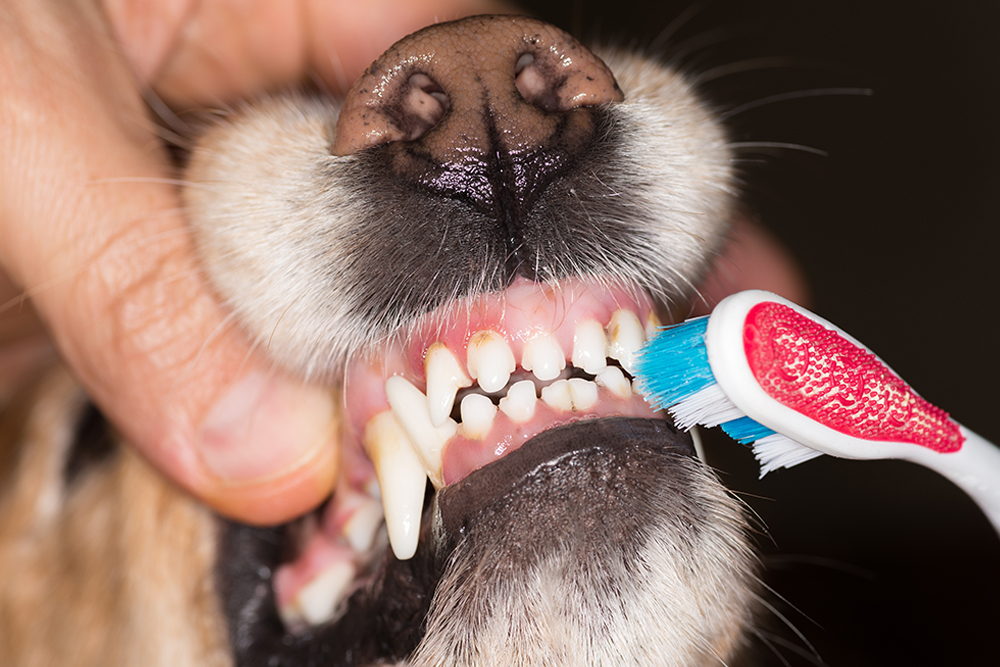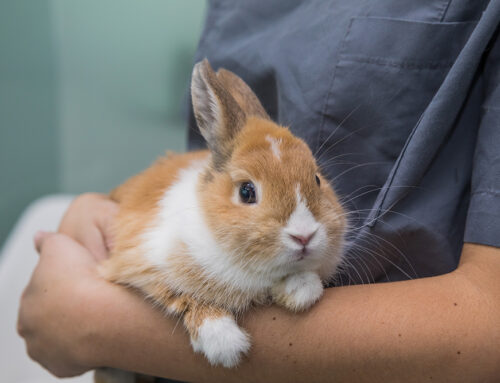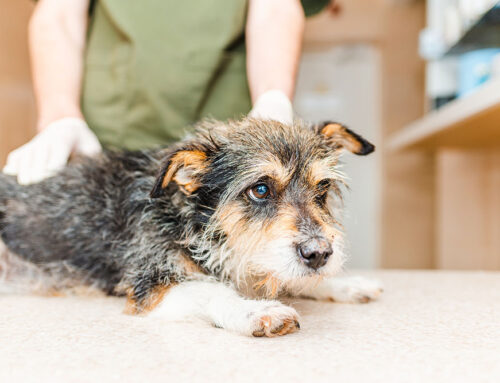Anesthesia: Why Do Pets Need it Just to Have Their Teeth Cleaned!?
Heather Toyne, DVM
Picture this:
A caring and gentle veterinary technician is getting ready to scale a dog’s teeth. Sara the technician’s ear scratches are legend and no dog can resist her. She lines up her sharp instruments and asks Turbo, a friendly Italian Greyhound, to hop up on the table and open wide. Sara shines a 1000 megawatt bulb into Turbo’s mouth to highlight the spots of tartar and goes to work, gently scraping the tartar off the teeth. Sara makes sure to get into the crevices, on the back side of the teeth and underneath the gums to get all of the tartar, not just the stuff on the surface. If Turbo gets a little wiggly, Sara takes a break from her scraping and lulls him back to calmness with her ear scratching. She then uses the pneumatic polisher in order to get out all the microscopic scratches she has just etched into the teeth. Turbo hops down and takes a treat from Sara and his mom schedules another appointment in six months. No anesthesia required!
Realize this:
As you can probably guess, this scene is fictional. Dogs are about as likely to sit still while the inner surface of their last molar is scraped as they are to do the laundry. Not only that, but they may be harmed by those sharp instruments if they wiggle. In addition, it is impossible to take dental x-rays on an awake pet. My dentist thinks it is important to have x-rays done annually even though I have the ability to complain about aches and pains. Our patients do not complain when their mouth hurts so it is doubly important to take x-rays or we are missing disease. Even in pets who appear to have perfectly healthy mouths, a study shows that a good percentage have hidden disease1. We can’t treat disease we don’t know exists.
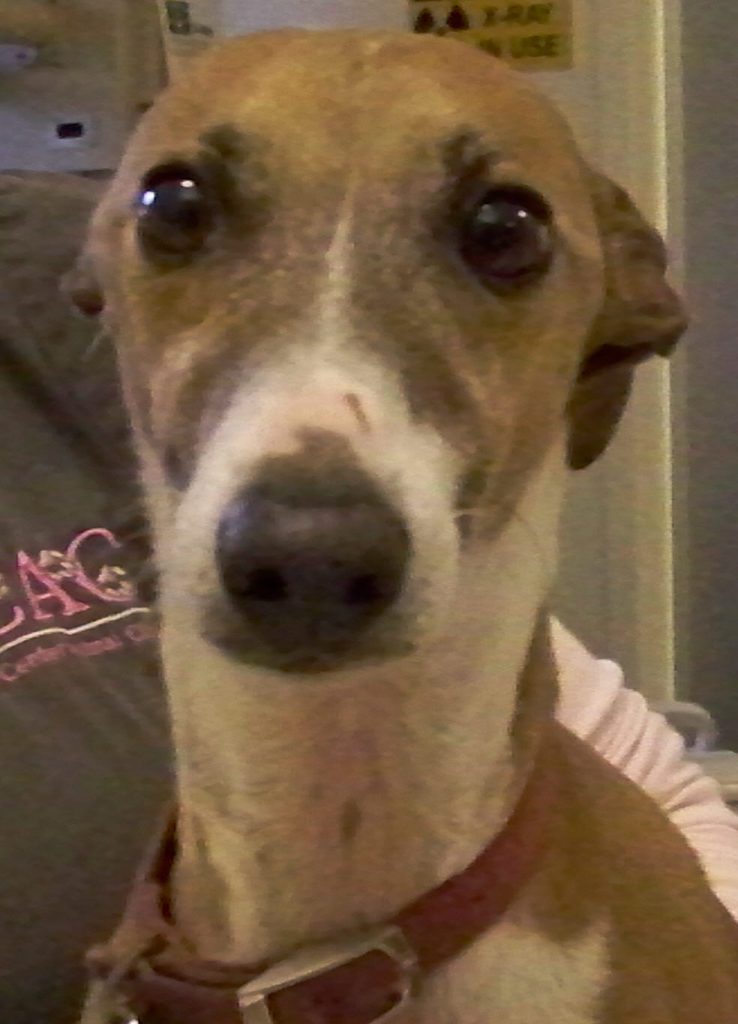
Turbo, an Italian greyhound
Here’s the reality:
So the previous story is fictional but Turbo is a real patient here at PCAC and here is his real story. Turbo had been getting his teeth scaled without the benefit of anesthesia every 6 months for the past five years. Dr. Noone saw Turbo for a check up and noticed some moderate tartar build up, nothing terribly bad to the naked eye. Dr. Noone estimated that the periodontal disease was moderate in severity and suggested a dental procedure to address this.
However, during the dental procedure, the periodontal disease was found to be much more severe than he could see on at Turbo’s exam. Ten of the teeth were actually so diseased they were loose! This was not able to be detected on Turbo’s awake exam, either by Dr. Noone or the non-anesthetic dental providers.
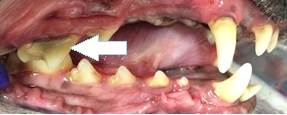
Moderate tartar on Turbo’s teeth
For a tooth to be loose, the disease is end-stage; it has mostly destroyed the attachment of the tooth root to the jaw bone! In addition, x-rays revealed that the teeth’s attachment to the jaw bone was severely compromised in many more teeth.
In all, Turbo had to have half of his teeth extracted due to severe periodontal disease that was never properly addressed. Turns out, the non-anesthetic dental cleanings that Turbo routinely had were only removing the tartar on the crowns of the teeth. The tartar and bacteria that was on the root of the tooth had been advancing for years. The teeth looked fairly good but were actually very diseased and painful. Dr. Noone’s estimate of the severity of the disease was influenced by the relatively clean crowns of the teeth, he couldn’t see the roots after all! This highlights one of the dangers of non-anesthesia dental cleanings, it makes things look better while the problem brews beneath the surface. Turbo’s mom was understandably upset that her pup has been suffering in silence for years when the non-anesthetic dental provider claimed they were helping.
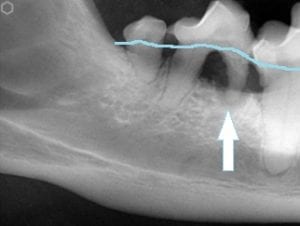
X-ray of Turbo’s lower right jaw showing that the jaw bone supporting the molars has been eaten away by bacteria, the line depicts where the bone should be. The arrow points to the root of a tooth that has no attachment to the jaw bone at all.
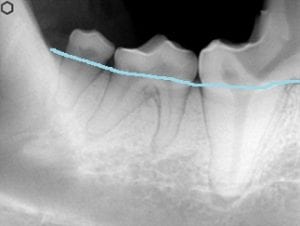
X-ray of a healthy lower right jaw with the teeth solidly anchored in bone.
Anesthetic Safety:
We’ve established that effectively and safely scaling the teeth and taking oral x-rays requires anesthesia. How do we provide this safely? Modern anesthesia administered by highly trained, licensed and vigilant staff is the answer. During the procedure, your pet is assigned three staff members to make sure their anesthesia goes as smoothly as possible from start to finish.
- To start, pets are given an injection of a sedative. This calms them and reduces the amount of anesthetic gas we need to administer.
- Nerve blocks are also used to block the pain sensation to the brain, less pain stimulus means still less anesthetic gas is needed.
- The anesthetic gas that we use requires minimal metabolism, there is almost nothing that the liver or kidneys have to process.
- During the procedure, a certified veterinary technician and veterinarian constantly monitor the vital signs with their eyes and ears and also with sophisticated instruments. The measurements are recorded every 5 minutes so minor trends are noticed and anesthesia is appropriately adjusted. When the procedure is over, we turn off the gas and let the pet breathe oxygen and they are moving around within minutes.
- The recovery technician then continues to monitor their vital signs and make sure they are recovering well and comfortable until they go home.
The full story:
If you are asking for a dental procedure for your pet minus the anesthesia, your heart is in the right place. You want him to have all the benefits and none of the risk; we all want that! But Turbo’s tale illustrates that non-anesthetic dental “cleanings” have neither the benefit nor the safety some would have you believe. With this knowledge you can see that an anesthetic dental procedure performed by highly trained and licensed individuals is the best choice for your furry loved ones.
- Verstraete et al, presented in the American Journal of Veterinary Researchin 1998, full mouth radiographs obtained of clinically normal animals found that 28% of the dogs and 42% of the cats had clinically significant lesions found.


